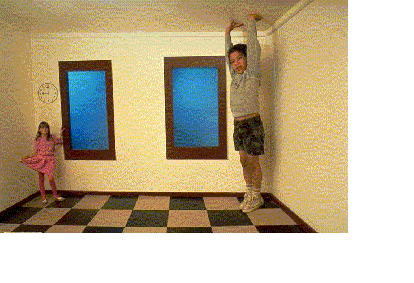

Hi,I'm Sarah Udal and this is my web page about optical illusions. This topic is particularly interesting to me as it integrates my main degree subject which is psychology with art, which having studied at A level is one of my interests. To start with here is one of my favourite illusions. It is an ambiguous figure which means that it can be perceived in more than one way like the famous old woman/young woman illusion .
The Rabbit/Duck Illusion

Perception is the process through which sensations are interpreted using our knowledge and understanding of the world. One goal of our perceptual system is to keep the appearance of objects constant, even though their impressions on our retinas are continually changing. However our perceptual system does have some limitations and interpretations of the world are sometimes mistaken. Optical illusions are a category of perceptual failures. Illusions come about in part because the perceptual system is so active, constantly filling in gaps and providing interpretations that go beyond the information provided by the senses. To see many common optical illusions and their perceptual explanations click here .
I was particularly pleased to find the web page written by Richard Gregory as he is among the honorary staff within the department of psychology. On the page there is a great example of an optical illusion which can be seen on the wall of a cafe at the bottom of St Michaels Hill here in Bristol.


A good place to see optical illusions in Bristol is the Exploratory where they have an Ames room.

The room looks like a normal rectangular room to an observer looking through the peephole, it is in fact shaped so that its left corner is almost twice as far from us as its right corner. We do not correct for this distance as we have been led to believe that we are looking at a normal room. Any object size remains relatively constant no matter how far its distance from us. The perceived size of an object increases with both retinal size of the object and the distance perceived, in accordance with the size-distance invarience principle. Thus, as an object moves away from the perceiver the retinal size decreases but the perceptual distance increases and the two changes cancel each other out resulting in consistency. This principle explains the Ames Room and the Moon Illusion .
To localize objects first we have to segregate them from one another and then organise them into groups. One principle of organisations that we organise stimulus into regions corresponding to figure and ground. Sometimes figure and ground decisions cannot be made unambiguously because of the nature of the figure. In Rubins face/vase figure we see figure-ground reversal, in this illusion the brain is constantly recomputing what it sees.

This is an advanced version of the classic face/vase illusion designed by Roger Shepard, a Stanford psychologist. You can either see two profiles or an obscured face behind a candlestick.
Optical illusions are applied to everyday life to improve safety. At one traffic circle in Scotland, 14 fatal accidents occurred in 12 months, at least in part because drivers failed to slow down as they approached the circle. Warning signs failed to solve the problem so Gordon Denton, a British psychologist proposed an ingenious solution based on optical illusion. White lines were painted across the road leading to the circle in a pattern that resembled this:
/ / / / / / / / / / / /////
Crossing these ever closer spaced lines at a constant speed gave the drivers the impression that their car was accelerating and their automatic response was to slow down (Denton, 1980). This dramatically reduced the accidents occurring at the traffic circle and strategies such as this are now used extensively on the roads.
In the following illusion a square is seen even though it is not actually there, this illusion belongs to a class of illusion called subjective contours.

In this illusion the perceptual work is done automatically without conscious awareness. The square appears to be lighter than the background as well as to lie on top of it. The more common version of this illusion is the Kanizsa triangle.

During the 1960's, Dr Bella Julesz was the first to use 3D images made up of randomly placed dots to study depth perception in human beings. In the early 1990's artists advanced this technique and created a new art form known as Magic Eye .
Here is a great Magic Eye picture. Can you see a howling wolf?

Despite the extensive research on illusions, psychologists are still struggling to find a good way to classify them. This is because people vary somewhat in their responses to illusions and most illusions involve several explanations not just one.